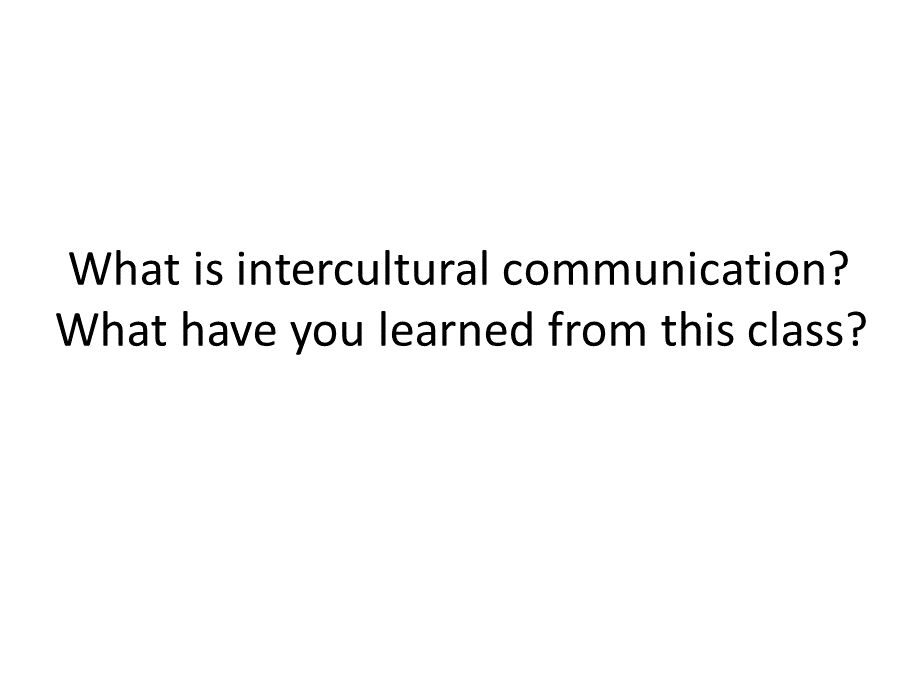跨文化交际期末考问题及答案.pptx
《跨文化交际期末考问题及答案.pptx》由会员分享,可在线阅读,更多相关《跨文化交际期末考问题及答案.pptx(45页珍藏版)》请在冰点文库上搜索。

Whatisinterculturalcommunication?
Whathaveyoulearnedfromthisclass?
3.InterculturalCommunication,Samovar&PorterInterculturalcommunicationiscommunicationbetweenpeoplewhoseculturalperceptionsandsymbolsystemsaredistinctenoughtoalterthecommunicationevent.interculturalcommunicationreferstoanycommunicationbetweentwomembersofanyculturalcommunities.,InternationalcommunicationInterracialcommunicationInterethniccommunicationIntraculturalcommunication,FormsofInterculturalCommunication,4.ElementsofInterculturalCommunication,Perceptions(beliefs,values,attitudes,worldviews,socialorganizations)Verbalprocesses(thewaysinwhichculturesemploysymbolstoportraythingsandexperiences)Nonverbalprocesses(sharethoughtsandfeelingsbywayofbodilybehavior,timeandspace)Contextualelements(business,educationandhealthcare,tourismandpersonalrelationships),Wecanusesomeexamplesaboutthefilm“guasha”whichwesawintheclassroomtoillustratethat:
1.HowdidChineseandAmericanperceiveParentsbeatingtheirownchilddifferently?
Chinese:
ToshowrespecttotheotherorgivethefacetotheotherAmerican:
Illegalasthechildabuse,Warmup,2.WhatisagoodfriendinChineseandAmericanculture?
Chinese:
BeloyaltoeachotherandneverbetrayeventolieAmerican:
Behonestandconstructiveandhelpful,Warmup,3.HowdidSunwukonginAJourneytotheWestrepresentthetraditionalChinesevaluesandethics?
Chinese:
Warmhearted,compassionate,perseverantAmerican:
Bad-tempered,violent,Warmup,WhenpeoplefacethesamethingindifferentcountrieshavedifferentreactionsAyoungladysminiskirtwasaccidentallytornopenbyayoungman.Wecandecidewheretheycomefromaccordingtotheirresponsestothisincident.,Warmup,Beforethemansayingsorry,thewomanboweddownandsaidinatendervoice:
sorry,itisallmyfault.Itisallthebadqualityofmyskirt.IamsorryforthetroubleIhavebroughttoyou.,JapanJapanese,Over-courtesyandmale-dominated,Warmup,Beforethemansayingsorry,thewomangavehimaname-cardandsaid:
“Thisismylawyersphonenumber.Hewilltalkwithyouaboutyoursexharassment.Seeyouinthecourt.”,AmericaAmerican,Aplacewherelawtalks!
Warmup,Beforethemansayingsorry,thewomancoveredthetornpartoftheskirtwithanewspaperinhandandshylysaid:
“Sir,canyousendmehome?
Itisnotveryfarfromhere.”Thentheyoungmanputhiscoatonthegirlandcalledataxitosendherhome.,EnglandEnglishman,Gentleandconservative,Warmup,Beforethemansayingsorry,thewomangurgledandputherhandonthemansshoulder:
“Sir,ifyoudonotmind,youcanbuymearedrosetoshowyourapology.”Thenthemanboughtheraroseandtheywenttoahoteltogethertostudymoreabouttheskirt.,FranceFrench,Friendlyandromantic,thedifferencesbetweenverbalcommunicationandnon-verbalcommunication,Boththeverbalandnonverbalarethemostpowerfulmeansofcommunication.buttherearealotdifferencesbetweenthem.Usuallywemakeourselvesunderstoodbyusingdifferentlanguage.butifwemeetsomeonewhocantunderstandourmeaningweonlycanuseourbodylanguage.Itisveryusefulbecauseitcanhelpyoumakeyourselfeasilyunderstood.Inotherwords,bodylanguageisntlimitedwithNationalboundaries.Althoughwemaynotrealizeitwhenwetalkwithotherswemakeourselvesunderstoodnotonlybywords.Bodylanguageisusedespeciallytoexpressfeelings.Thisisusuallydescribedasgivingoutdoublemessages-onemessageinwordsandanoppositemessageinbodylanguage.Itisalsodifficulttolieorcoverupourfeelingsthroughbodylanguage.Wesendmessagestothepeoplearoundusalsobyexpressionsandbodymovements.,Researchhasshownthatmostpeoplepaymoreattentionto,andbelievemorereadily,theirimpressionofhowapersonactsthroughbodylanguagethanwhatissaidthroughwords.Asaconsequencewetendtodoubt,orputaquestionmarkbehind,thespokenwordsiftheydonotcorrespondwiththelanguageofthebody.Thedifferencebetweennon-verbalandverbalcommunicationisyouuseyourbodytocommunicatethings,however,withverbalcommunicationyoujustuseyourvoicetocommunicatethingstootherpeople.,Verbalcommunication,althoughwesometimesthinkofitasonlyspokenlanguage,bymanypeoplesdefinitionoftenincludesmorethanthat.ItencompassesOralcommunication(whichisthetermmoreoftenusedforspokencommunication),includingthingslikerate,volume,pitch,articulation,andpronunciation.Itcanalsoincludesignlanguage,visualcommunication,andwrittencommunication.althoughsometimestheseotherthingsarelistedseparately,dependingonwhoisdefiningtheterms.,Nonverbalcommunicationincludesthoseimportantbutunspokensignalsthatindividualsexhibit,specifically:
bodylanguage(encompassingcarriage/posture,appearance,listening,eyecontact),handgestures,andfacialexpressions.Non-verbalcommunicationmakesupthemajorityofthecommunicationthatweengageis,althoughitisntalwaysconscious.Averygoodexampleis:
Amancomeshomelate,hearsfromthekitchentheslammingofpotsandpansandcupboarddoors.Heentersthekitchen,askshiswifeWhatswrong,honey?
Sheanswers,Nothing!
assheslamsanothercupboarddoorandrollshereyestowardtheceiling.ShehasspokenthewordNothing,butitisherunspokencommunicationthattellshimthatnothingisnottherealanswer.Itisclearlycommunicatedbyheractions.Atrulyeffectivecommunicatorwilltrainhimorherselfinnonverbalcommunicationaswellasothertypes.,FormsofCommunication,1.Verbalcommunication:
whichincludes:
a)Oralcommunicationsuchastalkingtooneself,dialogue,discussionbetweentwopeople,telephonecalls.b)Visualcommunicationsuchasmaps,graphic,trafficsignals,advertisementetc.c)Writtencommunicationsuchasmemos,lettersreports,papers.d)Electronicwhichiscommunicationfacilitatedbyaninterfacewithacomputer,modem,telephonefax,E-mailetc.2.Non-verbalcommunication:
Suchasbodymovementfacialexpressionandvoiceetc.,NonVerbalCommunication,Thesenderhasatleastfourmainsetsofphysicalnonverbalcues:
face,eyes,body,andvoice.a)Thefaceincludesfrowning,smilingandgrimacing/makingface.b)Theeyescansignalbydirectionofgaze.c)Thebodyoffersposturepositionsofarmsandlegsanddistancing.d)Voiceincludestoneandspeechrhythm.,KindsofNon-VerbalLanguage,1.Languageoffacialexpression2.Languageofeyecontact3.Languageofposture4.Languageofvoice5.Languageofapparel/attire6.Languageofcolor7.Languageofodor8.Languageoftime9.Languageofspace,AccordingtotheHofstedesmodel,howdoescollectivismaffectJapaneselife?
Hofstedethinkthatcultureisinanenvironmentofpeoplescommonpsychologicalprocess,isnotanindividualcharacteristics,butwiththesameeducationandlifeexperienceofalotofpeoplehaveincommonpsychologicalprocedures.Differentgroups,regionsorcountriesofthisprogramaredifferences.Theseculturaldifferencescanbedividedintofourdimensions:
powerdistance,uncertaintyavoidanceindex,individualismversuscollectivismandmasculineversusfeminality.,Grouporientedsociety:
atightlyknitsocialframework;individualscanexpecttheirrelatives,orotheringrouptolookafterthem.(WeCultureorI-lessCulture)Onthecollectivistside,wefindsocietiesinwhichpeoplefrombirthonwardsareintegratedintostrong,cohesivein-groups,Collectivismreferstoacombinationofclosesocialorganizations,whichtendtowithinagroupandoutsidegroupstodistinguish,theyexpectagroupwithinthestafftotakecareof,butalsotothecommunitytomaintainabsoluteloyaltyinreturn.Wecanfindmanyexamplesinourdailylife,whichstressgroupbehaviorssuchas(Weal)(bewellpopular)(goodforallages)(theproductisgoodforall,soitisindeedgood)(thecustomersalloverthecountrysatisfy.).,Japanisadvocatingcollectivismsociety,thestaffhasanattachmenttotheorganization,shouldbeeasytobuildaharmoniousrelationshipbetweenemployeesandmanagers.Japaneseregardthesakuraastheembodimentofspring.Sakurablossomswellanditmeansthatthisyearisaharvestyear.Inaddition,itismoreimportantthatwhensakurablossoms,itsflowersisroundandcluster,insinuatingJapanesecollectivism.,Japaneseisnotanaturalcollectivismadvocates.Theirbehaviorisaproductofthetraining.Fromprimaryschoolage,mostchildrenwilljointheclubsthatschoolsorganize,suchassports,music,painting,etc.Here,ratherthantrainedbytheprofessionalskills,theyarenurturedbycollectivism,Fortheschoolandstudents,communityactivityismoreimportantthanschoolsinformallearning.Ifachildispopularinthecommunity,heorshewillberespected,andevenfeeltheburningeyesoftheoppositesexchildren.,InJapanesecompanies,collectivismmeansloyaltytothecompanyandinternalunityandcooperation.Enterprisenotonlyiseveryonescommunityofinterests,butalsoasymbolofhisidentityandsocialstatus.Thecompanyislikea“home”,andtheleaderisthe“home”parents.Theymustbeprestigiousandtakecareofthefeelingsofsubordinates.,InJapan,communicatingwithpeople,thefirsttobeconsideredisthegroupwhichhebelongsto,followedbyhispersonalprofessionalidentity.Ifyouhavenogroup,youwillhavenosocialstatus.Aslongasyouareloyaltothecompany,youranyneedswillbemet,andanyproblemcanberesolvedthroughthecompany.Japaneseworkersarediligent,willingtoworkovertime.Evenduringthefinancialcrisis,employeesarewillingtooffertheirownmoneytohelpthecompanycrossoverthestorm.,Whatarethemaindifferencesbetweenchineseeducationsystemandwesterneducationsystem,Thebasicissueofeducationiswhatkindofpeoplewewanttocultivatetobe,andhowtocultivatethem.Theconceptofvalue,purposeofeduc